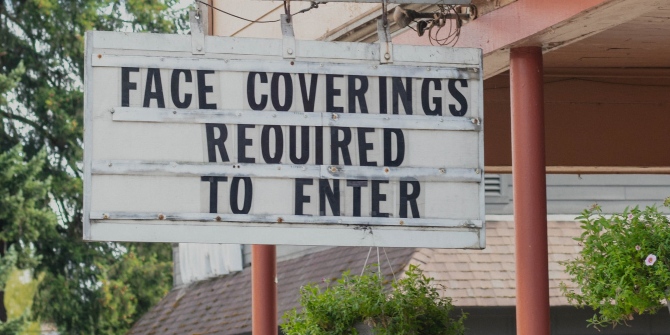 The new Republican controlled Congress has put further restrictions on abortion near the top of its agenda for this legislative session. Rebecca J. Kreitzer looks at another arena where the GOP is also working to expand abortion restrictions – in the American states. She writes that in the last two decades, more than 700 state laws have passed which while keeping abortion legal, make it nearly inaccessible. She also finds that those states with Democratic women legislators are more likely to block more restrictive abortion policies, rather than expand access.
The new Republican controlled Congress has put further restrictions on abortion near the top of its agenda for this legislative session. Rebecca J. Kreitzer looks at another arena where the GOP is also working to expand abortion restrictions – in the American states. She writes that in the last two decades, more than 700 state laws have passed which while keeping abortion legal, make it nearly inaccessible. She also finds that those states with Democratic women legislators are more likely to block more restrictive abortion policies, rather than expand access.
The issue of legal abortion is near the top of the Republican legislative agenda in Congress. In just the first three days of the new legislative session, Republicans in Congress introduced five bills to restrict access to abortion in various ways. A vote on a controversial 20-week gestational ban scheduled to take place on the anniversary of the Supreme Court case Roe v. Wade (1973) was abruptly cancelled because of lack of support from Republican women. Despite this setback, Republicans passed a ban on the already-illegal public funding of abortions and introduced yet another abortion bill that would require ultrasounds before abortions can occur.
The proposed gestational ban on abortions in Congress highlighted some critical divisions in the national Republican Party and has been tabled for the time being. Despite this, these types of policies are already in effect in ten states and in late January, three additional states introduced similar bills. Since the early 1990s, the number and variety of state laws that place restrictions on abortion has grown rapidly. There has been an unprecedented wave of anti-abortion policies in the last few years, with more restrictive abortion policies enacted between 2011 and 2013 than the previous decade. According to the prominent anti-abortion news source LiveAction, Roe v. Wade (1973) requires that abortion be legal, but not that it be easily accessible. Strategic legislators recognize this distinction and no longer seek to make abortion illegal; instead they seek to make it virtually inaccessible. This strategy of “legal but inaccessible” has resulted in the adoption of a plethora of restrictive abortion policy; more than 700 of these state laws have passed since the early 1990s. The adoption of legislation that expands or protects existing access to abortion is also increasing, albeit at a much slower rate than restrictive policies.
Figure 1 – The Spread of Restrictive Abortion Policy, 1993 – 2013

Note: Maps show how many of the 29 anti-abortion rights policies included in the study were adopted by the states in each year.
In a practical sense, this incrementalist approach to regulating abortion looks a lot like passing policies that restrict abortion from all different directions and seeing which policies stick. This poses a challenge for scholars trying to determine the abortion policymaking environment in the states. Previous research on abortion policy has made significant gains in understanding the predictors of specific abortion policies, and in particular, the role that public opinion, religion, partisan control of the legislature, and the women legislators play more specifically. However, one lingering question is whether the lessons learned about the adoption of specific abortion policies are generalizable to other abortion policies. One way to answer this question is to look at the adoption of many different abortion policies and establish the average predictors of abortion policy adoption.
Taking this approach to studying abortion policy, several important trends emerge across the analysis of 29 anti-abortion rights policies and 8 pro-abortion rights policies. Public opinion, the religiosity of the state, and the political context go far in explaining a state’s abortion policy environment. However, there are some noteworthy differences when comparing the predictors of pro- and anti-abortion rights policies. Conservative public attitudes about abortion and a greater religiosity among the population make restrictive abortion policy more likely. State partisan politics, especially Democratic governors and female Democrats in the state legislature, decrease the probability of anti-abortion rights policies but focus their efforts on some specific policies more than others. Public opinion shapes pro-abortion rights policies, but not the religiosity of the state population. Restrictive policies are also shaped by Democratic legislatures, but not Democratic women or governors. One of the most surprising findings in this study is that while Democratic women are one of the most significant predictors of conservative abortion policy, they had no significant effect over policy that further codified the status quo or expanded access to legal abortion. It seems that Democratic women play “legislative defense” and thus are more effective at blocking hostile policies than passing liberal ones.
These findings emphasize how politics shape the abortion policy in the states. Public attitudes on abortion and the size of the religious population do not vary much over time, but trends in the partisanship of state legislatures do change. There were only three states with divided legislatures in 2012, the lowest number since 1928. When Republicans control the state legislature, increases in restrictive abortion policy are likely.
Resolving the question of what shapes state abortion policy is not just one of theoretical importance, it is of practical importance. The number of women affected by abortion policies is not small. Approximately 35-40% of all American women will have an abortion at some point in their life. As a result of restrictive abortion policies, clinics are closing at a record rate. For example, four states have only one clinic and a Texas law in 2014 threatened to close 19 clinics almost overnight. In 2011, 33% of American women of reproductive age lived in the 87% of counties without an abortion provider.
The question of what causes abortion policy in the states is also an important because these policies affect women differently. Low-income and minority women are five times more likely to have an abortion compared to higher-income women. Abortion restrictions such as mandatory waiting periods and prohibitions on Medicaid funding result in low-income and minority women being more likely to have later abortions, incurring higher costs and greater medical risks.
This article is based on the paper ‘Politics and Morality in State Abortion Policy’ in State Politics & Policy Quarterly.
Featured image credit: Toby Marks (Flickr, CC-BY-SA-2.0)
Please read our comments policy before commenting.
Note: This article gives the views of the author, and not the position of USApp– American Politics and Policy, nor of the London School of Economics.
Shortened URL for this post: http://bit.ly/1yH6S4i
_________________________________
 Rebecca Kreitzer – University of Iowa
Rebecca Kreitzer – University of Iowa
Rebecca Kreitzer is a fifth year Ph.D. candidate in the Department of Political Science at the University of Iowa studying American politics. Specifically, she is interested in gender and sexuality politics. Her research deals primarily with state policy adoption, diffusion, implementation and feedback. She will be joining the Public Policy Department at the University of North Carolina at Chapel Hill in the fall 2015.






